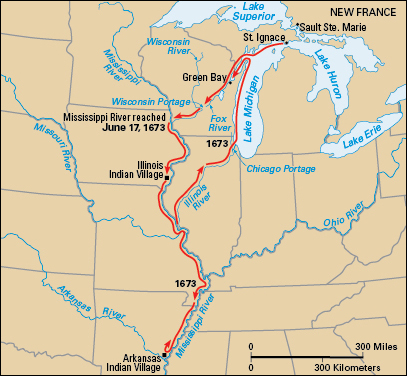Jolliet, Louis, << JOH lee eht, lwee >> (1645-1700), also spelled Joliet, was a French-Canadian explorer who led an expedition down the Mississippi River. He and Jacques Marquette, a French missionary, were probably the first white explorers to reach the upper Mississippi and parts of Illinois and Wisconsin.
Early life.
Jolliet was born near Quebec City in what was then the French province of New France (now Canada). His exact birth date is unknown, but he was baptized on Sept. 21, 1645. As a boy, he attended a school in Quebec run by Jesuit priests. Jolliet began to study for the priesthood when he was a teenager. But he later changed his mind and left school at the age of 22.
From 1669 to 1671, Jolliet explored much of the Great Lakes region for the government of New France. During this time, he became a skilled mapmaker and also worked as a fur trader. About 1670, Jolliet established a fur-trading post at Sault Sainte Marie in what is now Ontario, Canada. He traded guns, knives, and other items to First Nations trappers in exchange for beaver pelts, which brought great profits in France.
Discovery and exploration.
The Indigenous (native) people of the Great Lakes region often talked about a great waterway that flowed to the sea. They called it the Mississippi, which in their language meant big river. The French thought this river might flow west to the Pacific Ocean and provide a trading route to the Far East.
In 1673, Governor General Comte de Frontenac of New France sent Jolliet to find the Mississippi and trace its course. Marquette, a Jesuit priest who had worked among the First Nations as a missionary and knew their languages, was chosen to accompany Jolliet.
In May 1673, Jolliet and Marquette, accompanied by five other men, set out in two canoes from St. Ignace on northern Lake Michigan. They traveled through what is now Wisconsin to the Mississippi. See Marquette, Jacques.

As Jolliet and Marquette paddled down the Mississippi, they realized that the river flowed south, not west. They concluded that it probably emptied into the Gulf of Mexico. When the group reached the mouth of the Arkansas River, they began to encounter unfriendly tribes. A Native American man told Marquette that white people lived farther south on the Mississippi. Jolliet and Marquette assumed these people must be Spaniards who had settled near the Gulf of Mexico.
Fearing attacks by the Native Americans and the Spaniards, the party turned back. They returned to Lake Michigan through the area that became Illinois. Jolliet’s canoe overturned in the St. Lawrence River near Montreal, and all his maps and records of the journey were lost. He later made some maps from memory. The entire expedition took about five months.
Later years.
The government of New France gave Jolliet Anticosti Island in the Gulf of St. Lawrence as a reward for his service. He traveled up into Hudson Bay in 1679 and explored the coast of present-day Labrador in 1689 and 1694. On these expeditions, Jolliet made many hydrographs (maps of navigable waters). In 1697, he was appointed hydrographer of the king with headquarters in Quebec. He also taught navigation at a Jesuit college there.
